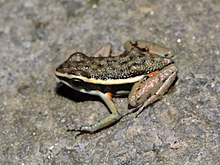| Ameerega berohoka | |
|---|---|

| |
| Conservation status | |
 Least Concern (IUCN 3.1) | |
| Scientific classification | |
| Domain: | Eukaryota |
| Kingdom: | Animalia |
| Phylum: | Chordata |
| Class: | Amphibia |
| Order: | Anura |
| Family: | Dendrobatidae |
| Genus: | Ameerega |
| Species: | A. berohoka |
| Binomial name | |
| Ameerega berohoka Vaz-Silva & Maciel, 2011 | |
Ameerega berohoka is a species of poison dart frog that is endemic to Goiás and Mato Grosso in Brazil.
Description
The adult male frog measures 19.2 to 23.4 mm long in snout-vent length and the adult female frog 21.9 to 24.3 mm. It has disks on the toes for climbing and no webbed skin. There are bright orange spots on the hind legs and groin. There are light yellow stripes on both sides of the body. The sides of the body are black in color and the venter is white or blue in color. Scientists note its aposematic coloration. The pupil of the eye is round in shape.
Etymology
The name berohoka means "big river" in the Karajas language.
Habitat
It can be found near the Araguaia River and near Itiquira. It can be found in cerrado biome, open and forested areas, and cultivated lands. It is associated with Brachiaria grasses. It is especially known in the sub-basins below the Araguaia River. Most sightings of the frog have taken place between 200 and 500 meters above sea level.
The frog's known range includes one protected area: Parque Estadual Serra Azul. It has also been found near Emas National Park.
Reproduction
Scientists infer that this frog has the same breeding habits as other frogs in Ameerega: The female frog lays eggs on the leaf litter. After the eggs hatch, the male frog carries the tadpoles to water.
Threats
The IUCN classifies this frog as least concern of extinction. What threat it faces comes from habitat loss associated with agriculture, livestock grazing, and charcoal. The construction of hydroelectric dams also poses a threat because it changes the subbasins below the Araguaia River.
Original publication
- Vaz-Silva W; Medeiros Maciel N. (2011). "A new cryptic species of Ameerega (Anura: Dendrobatidae) from Brazilian Cerrado". Zootaxa. 2826: 57–68.
References
- ^ IUCN SSC Amphibian Specialist Group; Instituto Boitatá de Etnobiologia e Conservação da Fauna (2023). "Ameerega berohoka". IUCN Red List of Threatened Species. 2023: e.T45727636A86254797. doi:10.2305/IUCN.UK.2023-1.RLTS.T45727636A86254797.en. Retrieved December 10, 2024.
- IUCN SSC Amphibian Specialist Group (2014). "Ameerega berohoka". The IUCN Red List of Threatened Species. 2014. IUCN: e.T45727636A45727639. doi:10.2305/IUCN.UK.2014-1.RLTS.T45727636A45727639.en. Retrieved 5 January 2018.
- Frost, Darrel R. "Ameerega boehmei Vaz-Silva and Maciel, 2011". Amphibian Species of the World, an Online Reference. Version 6.0. American Museum of Natural History, New York. Retrieved December 10, 2024.
- ^ Avery Dean; Anne Boyd; Roberto Mejia-Alberto (July 1, 2021). Ann T. Chang (ed.). "Ameerega berohoka Vaz-Silva & Maciel, 2011". AmphibiaWeb. University of California, Berkeley. Retrieved December 10, 2024.
| Taxon identifiers | |
|---|---|
| Ameerega berohoka | |
This Dendrobatidae-related article is a stub. You can help Misplaced Pages by expanding it. |